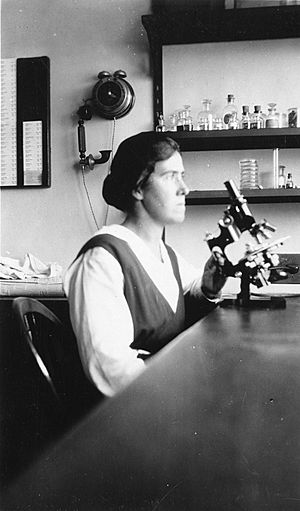Eleanor Carothers facts for kids
Eleanor Carothers (born December 4, 1882 – died 1957) was an American scientist. She was a zoologist, who studies animals. She was also a geneticist, who studies how traits are passed down. And she was a cytologist, who studies cells. Eleanor Carothers is famous for her important work with grasshoppers. She found key proof for something called independent assortment. This idea helps us understand how different traits are inherited.
Early Life and Education
Eleanor Carothers was born in Newton, Kansas, on December 4, 1882. She went to college at the Nickerson Normal College. Later, she earned her first two degrees from the University of Kansas. She received her Bachelor of Arts degree in 1911. The next year, in 1912, she earned her Master's degree.
Research Career
Eleanor Carothers started her science career at Pennsylvania State University. She was a special researcher there from 1913 to 1914. In 1914, she became an assistant professor of zoology at the university. She earned her Ph.D. degree in 1916. Carothers continued as an assistant professor until 1936.
During this time, she also worked as an independent researcher. She worked for the Marine Biological Laboratory from 1920 to 1941. In 1936, she moved to the University of Iowa. She was a research associate there until 1941. Her work at the University of Iowa was supported by the Rockefeller Foundation.
While studying and teaching, Carothers went on research trips. She traveled to the southern and southwestern parts of the United States. These trips happened in 1915 and 1919. At the University of Iowa, she did her most important work. She studied genetics and cells using grasshopper embryos. She looked at how different parts of chromosomes separated during cell division.
Her research was the first physical proof that chromosomes separate independently. This process happens during meiosis, which is how cells divide to create new life. This independent separation is a key reason why living things have so much genetic variety.
Later Life
Eleanor Carothers retired from the University of Iowa in 1941. She then moved from Iowa to Kingman, Kansas. Even in retirement, she kept doing research for the Woods Hole Marine Biological Lab. In 1954, she moved to Murdock, Kansas. She lived and continued her research there for the rest of her life. Eleanor Carothers passed away in 1957 when she was 75 years old.
Awards and Honors
In 1921, Eleanor Carothers received the Ellen Richards Research Prize. This award was given by the Naples Table Association. Her work on grasshopper embryos was also recognized in a special way. She received a "starred entry" in the fourth edition of American Men of Science. This book was published in 1927. Getting a starred entry was a very rare and important honor for a female scientist at that time. Carothers was also chosen to be a member of the National Academy of Sciences. She was also elected to the Academy of Natural Sciences of Philadelphia.
See also
 In Spanish: Eleanor Carothers para niños
In Spanish: Eleanor Carothers para niños



